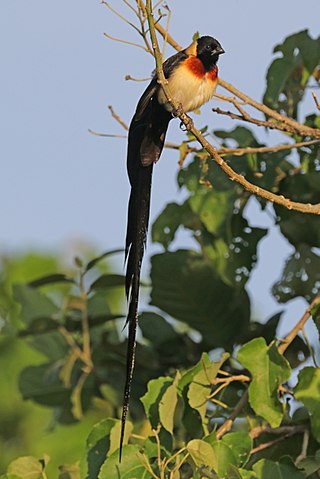
The indigobirds and whydahs, together with the cuckoo-finch, make up the family Viduidae; they are small passerine birds native to Africa.

Estrildidae, or estrildid finches, is a family of small seed-eating passerine birds of the Old World tropics and Australasia. They comprise species commonly known as munias, mannikins, firefinches, parrotfinches and waxbills. Despite the word "finch" being included in the common names of some species, they are not closely related to birds with this name in other families, such as the Fringillidae, Emberizidae or Passerellidae.

Brood parasitism is a subclass of parasitism and phenomenon and behavioural pattern of certain animals, brood parasites, that rely on others to raise their young. The strategy appears among birds, insects and fish. The brood parasite manipulates a host, either of the same or of another species, to raise its young as if it were its own, usually using egg mimicry, with eggs that resemble the host's.

The village indigobird, also known as the steelblue widowfinch or the Combassou finch, is a small songbird belonging to the family Viduidae. It is distinguishable from other indigobird species by bill and leg colours, the colour tinge of the male's breeding plumage, song, and to lesser extent, the nestling's plumage and mouth pattern. The bill colour can be red or white depending on the population, and there is some regional variation in the colour tone of the male's plumage.

The pin-tailed whydah is a small songbird with a conspicuous pennant-like tail in breeding males. It is a resident breeding bird in most of Africa south of the Sahara Desert.

The long-tailed paradise whydah or eastern paradise whydah is from the family Viduidae of the order Passeriformes. They are small passerines with short, stubby bills found across Sub-Saharan Africa. They are mostly granivorous and feed on seeds that have ripen and fall on the ground. The ability to distinguish between males and females is quite difficult unless it is breeding season. During this time, the males molt into breeding plumage where they have one distinctive feature which is their long tail. It can grow up to three times longer than its own body or even more. Usually, the whydahs look like ordinary sparrows with short tails during the non-breeding season. In addition, hybridization can occur with these paradise whydahs. Males are able to mimic songs where females can use that to discover their mate. However, there are some cases where females don't use songs to choose their mate but they use either male characteristics like plumages or they can have a shortage of options with song mimicry. Paradise whydahs are brood parasites. They won't destroy the eggs that are originally there but will lay their own eggs in other songbirds nest. Overall, these whydahs are considered least concerned based on the IUCN Red List of threatened species.








